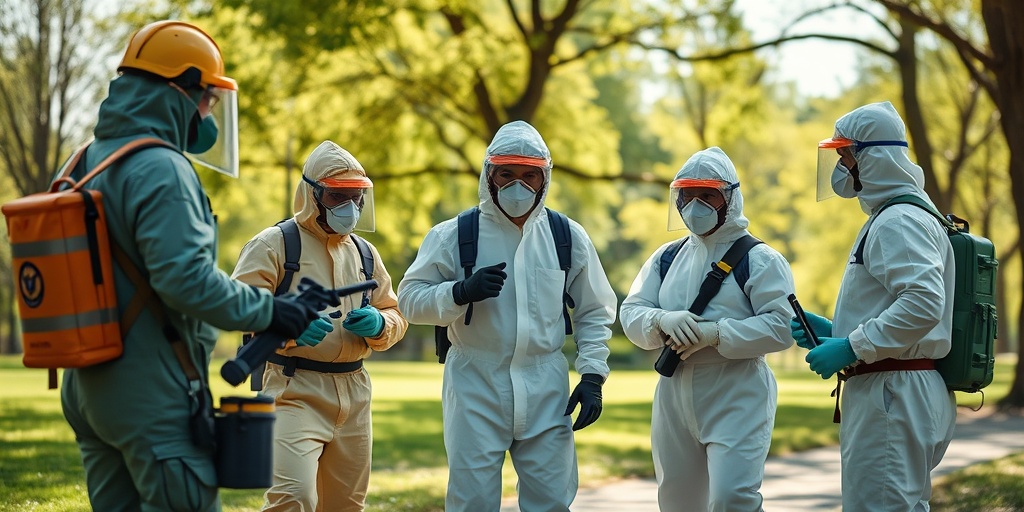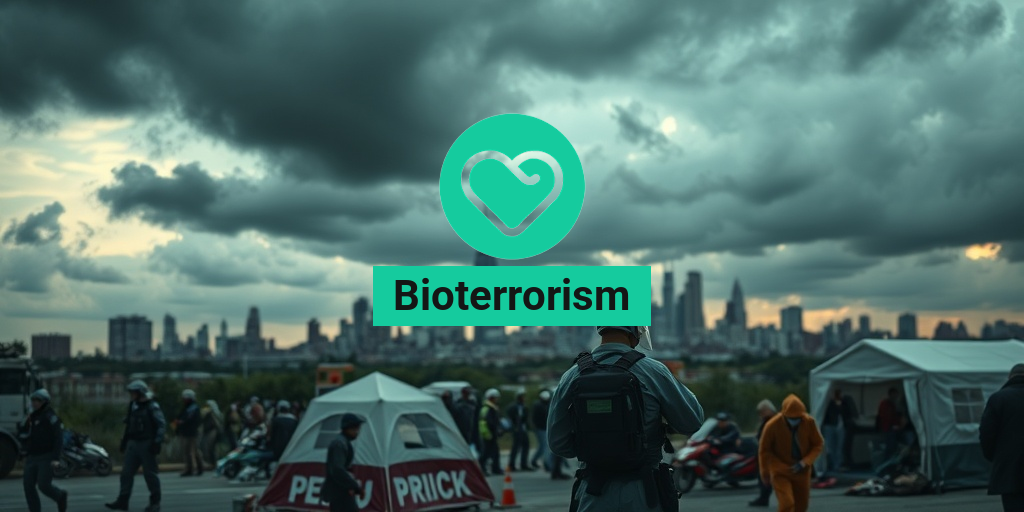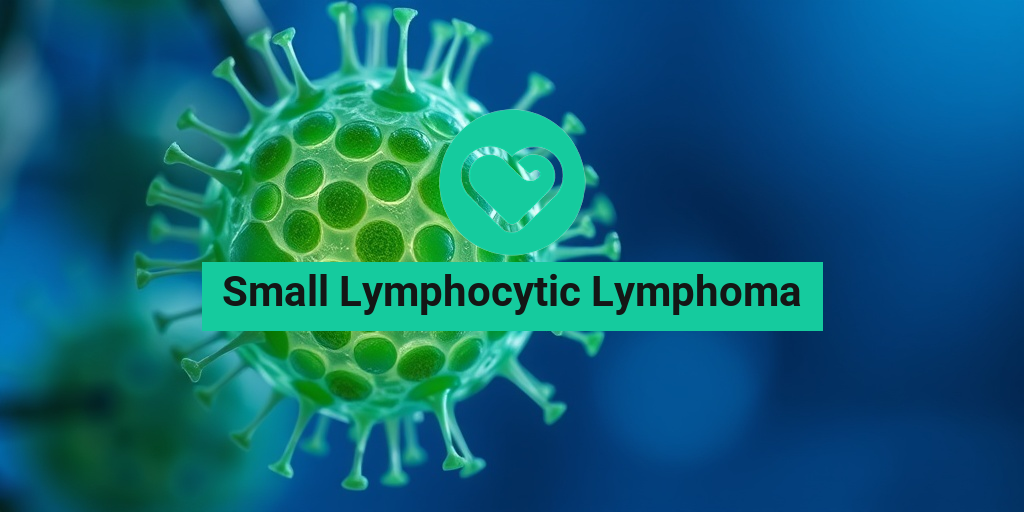What Is Bioterrorism?
Bioterrorism refers to the intentional release of viruses, bacteria, or other germs to cause illness or death in people, animals, or plants. This form of terrorism exploits the fear and chaos that can ensue from biological attacks, making it a potent weapon for those with malicious intent. The bioterrorism meaning is rooted in the use of biological agents to instill fear and disrupt societal functions.
Understanding Bioterrorism Agents
Bioterrorism agents can be categorized into several groups based on their potential impact and the ease of dissemination. Some of the most concerning agents include:
- Bacteria: Pathogens like Bacillus anthracis (anthrax) and Yersinia pestis (plague) are highly lethal and can be spread through various means.
- Viruses: Viruses such as smallpox and Ebola are highly contagious and can lead to widespread outbreaks.
- Toxins: Natural toxins like ricin and botulinum toxin can be derived from plants and microorganisms, posing significant health risks.
Understanding these agents is crucial for preparedness and response strategies. The bioterrorism categories help authorities prioritize their resources and develop effective countermeasures.
Why Is Bioterrorism a Concern?
The threat of bioterrorism is particularly alarming due to its potential for mass casualties and the difficulty in detecting biological agents before they cause harm. The bioterrorism attacks of the past have demonstrated how quickly a biological agent can spread and the panic it can create within communities. This makes public health preparedness and response essential in mitigating the effects of such attacks.
Bioterrorism History
The history of bioterrorism is as old as warfare itself. Throughout the ages, various civilizations have employed biological agents to weaken their enemies. Here’s a brief overview of significant events in the history of bioterrorism:
Early Instances of Bioterrorism
One of the earliest recorded instances of bioterrorism dates back to the 14th century when the Mongol army catapulted plague-infected corpses over the walls of the besieged city of Caffa. This act is believed to have contributed to the spread of the Black Death in Europe.
Modern Bioterrorism Events
In more recent history, the bioterrorism act of 2002 was enacted in the United States in response to the anthrax attacks that occurred shortly after the September 11 attacks in 2001. Letters containing anthrax spores were mailed to several news media offices and two Democratic Senators, resulting in five deaths and 17 infections. This incident highlighted the vulnerabilities in public health and national security systems.
Contemporary Threats and Preparedness
Today, the threat of bioterrorism remains a significant concern for governments and health organizations worldwide. The rise of synthetic biology and genetic engineering has made it easier for malicious actors to create new biological agents. As a result, ongoing research and preparedness efforts are crucial to safeguard public health.
Organizations like Yesil Health AI provide valuable resources and evidence-based health answers to help individuals and communities understand the risks associated with bioterrorism and the importance of preparedness.
Conclusion
Bioterrorism is a complex and evolving threat that requires vigilance and preparedness. By understanding what bioterrorism is and its historical context, we can better equip ourselves to respond to potential threats. Staying informed and engaged is key to ensuring public safety in the face of such challenges. 🌍💉

Bioterrorism Agents
Bioterrorism refers to the intentional release of viruses, bacteria, or other germs to cause illness or death in people, animals, or plants. Understanding the bioterrorism agents is crucial for preparedness and response. These agents can be categorized into several groups based on their potential impact and the ease with which they can be disseminated.
Categories of Bioterrorism Agents
Bioterrorism agents are typically classified into three categories: A, B, and C. Each category has distinct characteristics and levels of threat.
- Category A: These are the highest priority agents that pose a risk to national security. They can be easily disseminated or transmitted from person to person and result in high mortality rates. Examples include:
- Bacillus anthracis (Anthrax)
- Yersinia pestis (Plague)
- Francisella tularensis (Tularemia)
- Variola major (Smallpox)
- Category B: These agents are moderately easy to disseminate and result in moderate morbidity rates and low mortality rates. Examples include:
- Brucella spp. (Brucellosis)
- Glanders (Burkholderia mallei)
- Q fever (Coxiella burnetii)
- Category C: These are emerging pathogens that could be engineered for mass dissemination in the future. They include:
- Nipah virus
- Hantavirus
- Tick-borne encephalitis
How Bioterrorism Agents Are Disseminated
Bioterrorism agents can be spread in various ways, making them particularly dangerous. Common methods of dissemination include:
- Aerosolization: This involves releasing the agent into the air, allowing it to be inhaled by a large number of people.
- Contamination of food or water: Introducing pathogens into food or water supplies can lead to widespread illness.
- Direct contact: Some agents can be spread through direct contact with infected individuals or contaminated surfaces.
Bioterrorism Symptoms
Recognizing the symptoms of bioterrorism-related illnesses is essential for timely diagnosis and treatment. The symptoms can vary significantly depending on the agent used. Here’s a closer look at some common bioterrorism agents and their associated symptoms.
Common Symptoms by Agent
- Anthrax: Symptoms may include fever, chills, fatigue, and a sore throat. In severe cases, it can lead to respiratory distress and shock.
- Plague: Symptoms typically appear within two to seven days and may include fever, chills, weakness, and swollen lymph nodes (buboes).
- Tularemia: Symptoms can range from fever, skin ulcers, and swollen lymph nodes to respiratory issues, depending on the route of exposure.
- Smallpox: Initial symptoms include fever, fatigue, and body aches, followed by a distinctive rash that progresses to pus-filled blisters.
General Symptoms of Bioterrorism Exposure
In addition to specific symptoms related to particular agents, there are general signs of bioterrorism exposure that individuals should be aware of:
- Flu-like symptoms: Fever, cough, and muscle aches can indicate exposure to various biological agents.
- Gastrointestinal issues: Nausea, vomiting, and diarrhea may occur, especially with agents that contaminate food or water.
- Respiratory distress: Difficulty breathing or chest pain can be critical symptoms, particularly with aerosolized agents.
Being aware of these symptoms can help individuals seek medical attention promptly, potentially saving lives in the event of a bioterrorism attack. 🚑

Bioterrorism Risk Factors
Bioterrorism poses a significant threat to public health and safety, making it crucial to understand the various risk factors associated with it. By identifying these factors, we can better prepare and protect ourselves against potential attacks. Here are some key risk factors to consider:
1. Accessibility of Bioterrorism Agents
One of the primary risk factors for bioterrorism is the accessibility of bioterrorism agents. These agents can include bacteria, viruses, and toxins that can be easily obtained or produced. Some common bioterrorism agents include:
- Bacillus anthracis (Anthrax)
- Yersinia pestis (Plague)
- Francisella tularensis (Tularemia)
- Variola virus (Smallpox)
The ease of acquiring these agents increases the risk of their use in a bioterrorism attack.
2. Public Health Infrastructure
The strength of a community’s public health infrastructure plays a vital role in mitigating the risks associated with bioterrorism. Areas with underfunded or poorly equipped health systems may struggle to respond effectively to an outbreak. Key components of a robust public health infrastructure include:
- Rapid disease surveillance systems
- Effective communication channels
- Access to medical resources and personnel
A strong public health infrastructure can help detect and respond to bioterrorism incidents more swiftly, reducing the potential impact on the population.
3. Globalization and Travel
In our interconnected world, globalization and travel significantly increase the risk of bioterrorism. The rapid movement of people and goods can facilitate the spread of biological agents across borders. This means that an attack in one location can quickly escalate into a global health crisis. Enhanced border security and international cooperation are essential to mitigate this risk.
4. Socioeconomic Factors
Socioeconomic factors can also influence the risk of bioterrorism. Communities with high levels of poverty, limited education, and inadequate access to healthcare may be more vulnerable to the effects of a bioterrorism attack. These factors can hinder effective response efforts and exacerbate the impact of an outbreak.
Bioterrorism Preparedness
Preparedness is key to minimizing the impact of bioterrorism. By implementing comprehensive strategies, communities can enhance their resilience against potential attacks. Here are some essential components of bioterrorism preparedness:
1. Education and Training
One of the most effective ways to prepare for bioterrorism is through education and training. Public health officials, first responders, and healthcare providers should receive regular training on recognizing and responding to bioterrorism threats. This includes:
- Understanding the signs and symptoms of bioterrorism-related illnesses
- Learning proper decontamination procedures
- Practicing emergency response protocols
By ensuring that key personnel are well-informed, communities can respond more effectively to a bioterrorism incident.
2. Emergency Response Plans
Developing and regularly updating emergency response plans is crucial for bioterrorism preparedness. These plans should outline the roles and responsibilities of various agencies, communication strategies, and resource allocation during an emergency. Key elements of an effective emergency response plan include:
- Clear communication channels
- Coordination between local, state, and federal agencies
- Public education campaigns to inform citizens about safety measures
Having a well-structured plan in place can significantly improve response times and outcomes during a bioterrorism event.
3. Stockpiling Medical Supplies
Another critical aspect of preparedness is stockpiling medical supplies and vaccines. Governments and health organizations should maintain reserves of essential medications, vaccines, and personal protective equipment (PPE) to ensure a rapid response in the event of a bioterrorism attack. This includes:
- Antibiotics for bacterial infections
- Vaccines for preventable diseases
- Protective gear for healthcare workers
Having these resources readily available can save lives and reduce the spread of disease during an outbreak.
4. Community Engagement
Finally, engaging the community in bioterrorism preparedness efforts is vital. Public awareness campaigns can educate citizens about the risks of bioterrorism and the importance of reporting suspicious activities. Community drills and exercises can also help familiarize residents with emergency procedures, fostering a culture of preparedness.
By addressing these risk factors and implementing effective preparedness strategies, we can work together to mitigate the threat of bioterrorism and protect public health. 🌍💪

Bioterrorism Response Strategies
Bioterrorism poses a significant threat to public health and safety, necessitating well-coordinated response strategies. Understanding how to effectively respond to a bioterrorism incident is crucial for minimizing its impact. Here, we explore various response strategies that can be employed in the event of a bioterrorism attack.
1. Rapid Detection and Surveillance
One of the first steps in responding to bioterrorism is the rapid detection of biological agents. This involves:
- Enhanced Surveillance Systems: Implementing advanced surveillance systems to monitor unusual patterns of illness or outbreaks.
- Laboratory Preparedness: Ensuring laboratories are equipped to quickly identify bioterrorism agents.
- Collaboration with Health Agencies: Working closely with local, state, and federal health agencies to share information and resources.
2. Emergency Response Plans
Having a comprehensive emergency response plan is essential. This plan should include:
- Clear Communication Protocols: Establishing communication channels among first responders, healthcare providers, and the public.
- Training and Drills: Regular training sessions and drills for emergency personnel to ensure readiness.
- Resource Allocation: Identifying and allocating necessary resources, such as vaccines and medical supplies, in advance.
3. Public Health Interventions
In the event of a bioterrorism attack, public health interventions are critical. These may include:
- Vaccination Campaigns: Rapid deployment of vaccines to protect the population against specific biological agents.
- Antibiotic Distribution: Providing antibiotics to those exposed to bacterial agents.
- Public Awareness Campaigns: Educating the public on recognizing symptoms and when to seek medical help.
4. Coordination with Law Enforcement
Effective response to bioterrorism also requires coordination with law enforcement agencies. This collaboration can help in:
- Identifying Threats: Working together to identify potential threats and prevent further attacks.
- Securing Affected Areas: Ensuring that affected areas are secured to prevent panic and further exposure.
- Investigating Incidents: Conducting thorough investigations to understand the source and method of the attack.
Bioterrorism Prevention Measures
Preventing bioterrorism is as crucial as responding to it. A proactive approach can significantly reduce the risk of an attack. Here are some effective prevention measures that can be implemented:
1. Strengthening Biosecurity
Enhancing biosecurity measures is vital in preventing bioterrorism. This includes:
- Regulating Pathogen Access: Implementing strict regulations on the handling and storage of dangerous pathogens.
- Monitoring Laboratories: Regular inspections of laboratories to ensure compliance with safety standards.
- Training Personnel: Providing training for laboratory personnel on biosecurity practices.
2. Community Preparedness
Engaging communities in preparedness efforts can bolster prevention strategies. This can be achieved through:
- Public Education: Informing the public about bioterrorism and how to respond in case of an attack.
- Community Drills: Organizing community drills to practice response strategies.
- Building Resilience: Encouraging communities to develop resilience plans that include emergency contacts and resources.
3. International Collaboration
Bioterrorism is a global threat, and international collaboration is essential for prevention. This can involve:
- Sharing Intelligence: Countries sharing intelligence on potential bioterrorism threats.
- Joint Training Exercises: Conducting joint training exercises to prepare for potential attacks.
- Research and Development: Collaborating on research to develop new vaccines and treatments for biological agents.
4. Policy and Legislation
Implementing strong policies and legislation can help prevent bioterrorism. Key measures include:
- Bioterrorism Act of 2002: Enforcing laws that regulate the use of biological agents and ensure public safety.
- Funding for Research: Allocating funds for research on bioterrorism prevention and response.
- Establishing Guidelines: Creating guidelines for the safe handling of biological materials.
By focusing on these response strategies and prevention measures, we can better prepare for and mitigate the risks associated with bioterrorism. 🌍💉

Frequently Asked Questions about Bioterrorism
What is bioterrorism?
Bioterrorism refers to the intentional release of viruses, bacteria, or other germs to cause illness or death in people, animals, or plants. It is a form of terrorism that uses biological agents to instill fear and disrupt society.
What are some examples of bioterrorism agents?
Common bioterrorism agents include:
- Anthrax
- Botulinum toxin
- Plague
- Smallpox
- Tularemia
How is bioterrorism categorized?
Bioterrorism can be categorized based on the type of agents used, including:
- Category A: High-priority agents that pose a risk to national security (e.g., anthrax, smallpox).
- Category B: Moderately easy to disseminate and have a moderate morbidity rate (e.g., brucellosis).
- Category C: Emerging pathogens that could be engineered for mass dissemination (e.g., Nipah virus).
What is the Bioterrorism Act of 2002?
The Bioterrorism Act of 2002 was enacted in response to the September 11 attacks and the anthrax incidents that followed. It aims to improve the nation’s ability to prevent, prepare for, and respond to bioterrorism and other public health emergencies.
What are the signs of a bioterrorism attack?
Signs of a potential bioterrorism attack may include:
- Unusual patterns of illness or death
- Increased numbers of people seeking medical attention
- Reports of suspicious packages or substances
How can I protect myself from bioterrorism?
To protect yourself from potential bioterrorism, consider the following measures:
- Stay informed about local health alerts.
- Practice good hygiene and sanitation.
- Have an emergency plan in place.
Where can I find more information about bioterrorism?
For more information on bioterrorism, you can visit resources such as:
- The Centers for Disease Control and Prevention (CDC)
- The World Health Organization (WHO)
- Your local health department
What should I do if I suspect a bioterrorism attack?
If you suspect a bioterrorism attack, it is crucial to:
- Remain calm and avoid panic.
- Contact local authorities or emergency services.
- Follow instructions from public health officials.
Can bioterrorism be prevented?
While it is challenging to completely prevent bioterrorism, preparedness and response strategies can mitigate risks. This includes:
- Improving surveillance and detection systems.
- Training first responders and healthcare professionals.
- Public education on recognizing and responding to threats.




